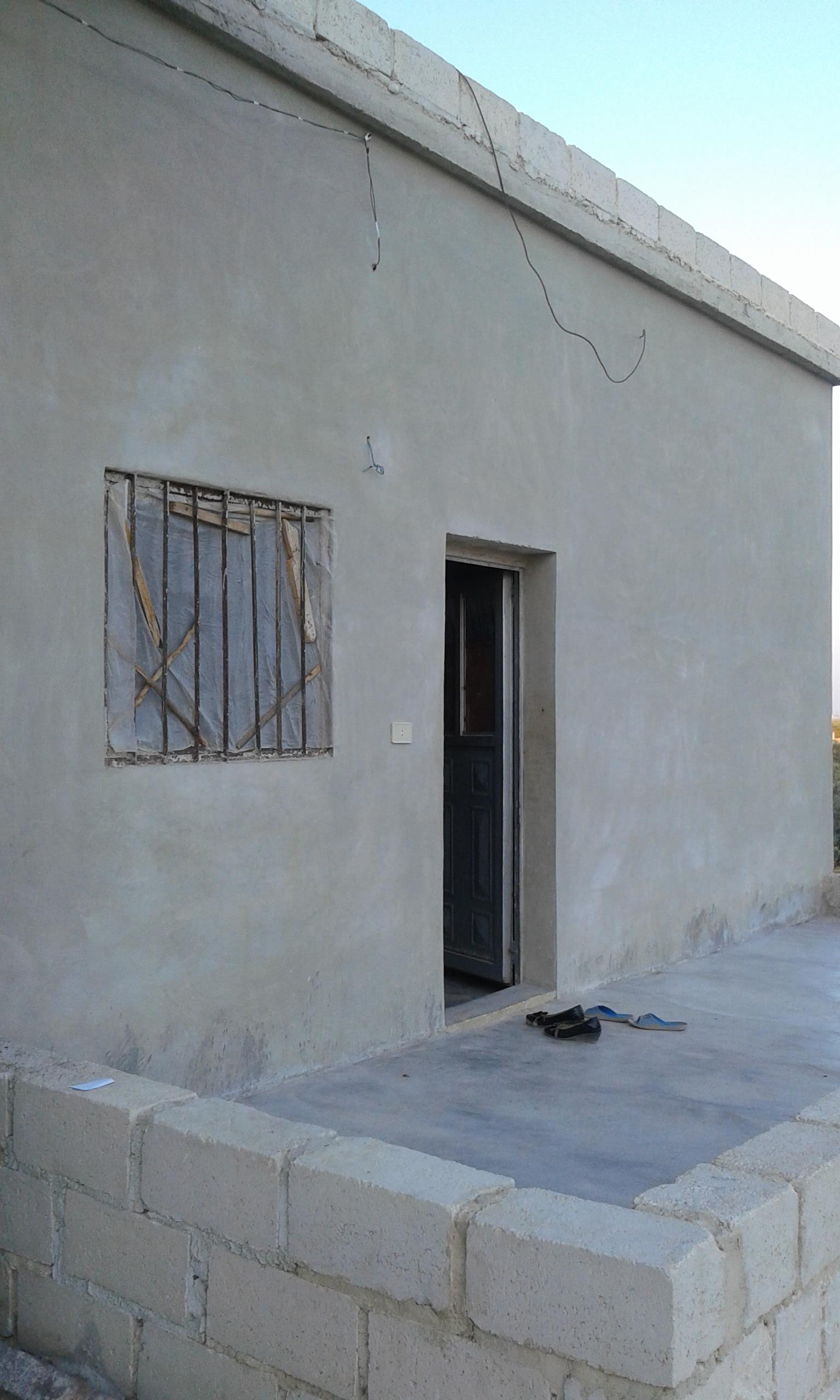Rebuilding Houses and Lives in Wadi al-Dayf

Umm Ahmad’s displacement began when her home in the village of Maar Hatat was shelled and reduced to rubble.
The 45-year-old widow and her seven children were forced to leave the ruins of their home and seek shelter in other villages nearby, moving from one house to another.
Umm Ahmad’s long and tiring journey is now over. Thanks to a project that has built her a small house just where her old one once stood, she and her family are now back where they belong.
A new scheme is rebuilding hundreds of houses in Wadi al-Dayf, allowing displaced families to return.
“The project is funded by Qatar Red Crescent and is managed by an organisation named Binaa,” project manager Sami Abu Salah told Damascus Bureau. “It was launched on July 11, 2015, and aims to build 400 housing units to replace damaged houses in Idlib’s southern countryside.”

According to Abu Salah, the project will cover 20 villages in the region. Each of these villages was chosen due to the high level of destruction suffered during battles between the government and the opposition, before the region was liberated.
Each new housing unit is 50 metres square and of a standard two-room design, costing 400,000 Syrian pounds (1,250 US dollars). This is to ensure funds are distributed equally amongst all beneficiaries.
Families are notified when the units are complete and ready for them to move in, upon which they also receive some basic furniture, kitchen equipment, and foodstuff.
The total cost of the project is 200 million Syrian pounds, and its target completion date is July 2016, a year after its launch. However, Abu Salah hopes to complete it in half this time, to provide the region’s displaced families with decent houses as soon as possible.
CREATING JOBS AND HOUSES
According to assistant engineer Wael al-Shahud, the beneficiaries are chosen according to their family size and the degree of damage to their house.
“Priority is given to poor families with orphans, war injured, or members with special needs,” said the 29-year-old.
Each family submits an application to the project, which is reviewed by a special committee. The damaged houses are then surveyed.
“The main aim of the project is to help people, and encourage them to come home,” Shahud added.
Rebuilding houses in Wadi al-Dayf has also created job opportunities for many local residents. More than 100 people are currently employed by the project, in jobs varying from construction to electricity installation and plumbing.
Abu Yehya is a 42-year-old builder who works for the project, along with his three children.
“All four of us had been unemployed for a very long time and were considering seeking refuge in Turkey,” he said. “When we heard of this project, we visited the manager and he hired us immediately. The work is long and hard, but even though we are exhausted by the end of each day, we are happy that we all have decent jobs that put food on our table”.
REBUILDING VILLAGES AND LIVES
Abu Muayad, a leader in Islamist rebel group Ahrar al-Sham, explained the reason for the particularly severe level of destruction in the area. After Maarat al-Numan was liberated in 2012, government troops withdrew and set up camp in al-Hamdiya and Wadi al-Dayf.
“They were besieged in these two villages for almost three years, during which there were numerous heavy clashes between them and the opposition,” said the 30-year-old.
“Following each battle, the government retaliated by shelling nearby villages with various types of heavy machinery, causing mass devastation. This went on until December 2014, when both al-Hamdiya and Wadi al-Dayf were liberated”.
As the displaced began to trickle back to their villages, they found their homes in ruins. Most families could not afford to fix their houses, as both building materials and construction work were expensive.
Asaad al-Amery told Damascus Bureau how hard it had been to return to a village in ruins. The extent of the destruction robbed his homecoming of all joy.
“When I came back, there was nothing left. The village had been completely destroyed save for one house the troops had used as a military barracks,’ said the 31-year-old. “Our memories had been buried amid debris and ruins.”
Amery praised the project as a blessing for the poor. By rebuilding houses for free, it is helping a large number of those who came back to nothing.
One such person was Hussam al-Asaad, who told Damascus Bureau that both he and his son lost their homes during the battle over Maarat al-Numan.
“Neither of us had the means to rebuild our houses,” said the 50-year-old, “So I had to seek shelter in a refugee camp along with 10 family members.”
The ruins of al-Asaad’s house have now been demolished and he is back living with his family in a new home on the site. All are very grateful that they will not have to face another winter in a camp.
Ahmad Kassar, president of Maarat al-Numan’s local council, told Damascus Bureau that the generosity of such projects is helping the Syrian people rebuild their lives.
“The Syrian people have suffered tremendously,” said the 39-year-old. “Wars kill and injure. They cause starvation and destruction. But despite the bitterness of our situation, we will not surrender. We will survive.”
Darin Hassan is the pseudonym of a Damascus Bureau contributor from Idlib countryside, Syria.
Read the Arabic version of this article here
